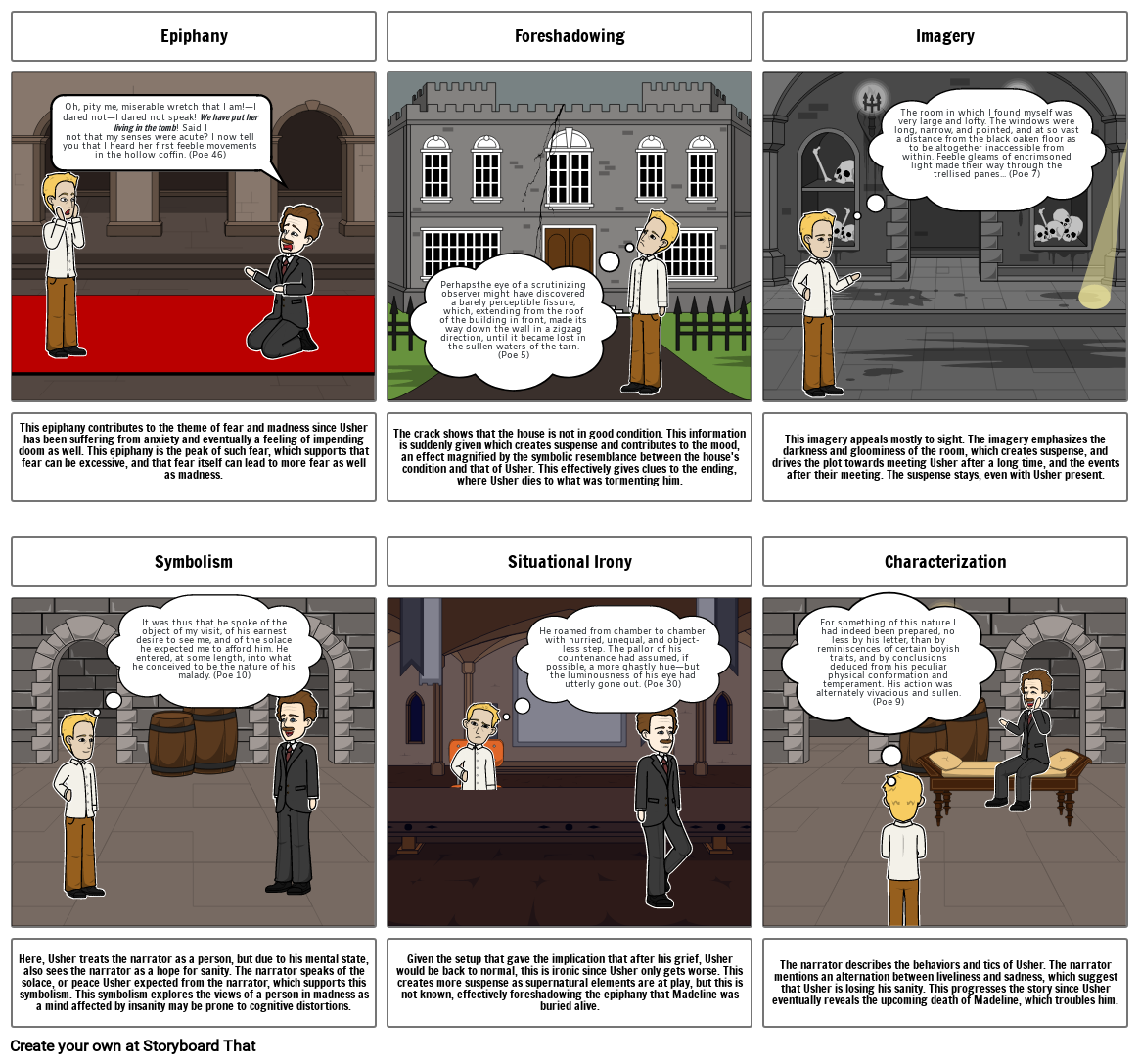The Fall of the House of Usher: Literary Devices

Storyboard Text
- Epiphany
- Oh, pity me, miserable wretch that I am!—I dared not—I dared not speak! We have put her living in the tomb! Said Inot that my senses were acute? I now tell you that I heard her first feeble movements in the hollow coffin. (Poe 46)
- Foreshadowing
- Perhapsthe eye of a scrutinizing observer might have discovered a barely perceptible fissure, which, extending from the roof of the building in front, made its way down the wall in a zigzag direction, until it became lost in the sullen waters of the tarn. (Poe 5)
- Imagery
- The room in which I found myself was very large and lofty. The windows were long, narrow, and pointed, and at so vast a distance from the black oaken floor as to be altogether inaccessible from within. Feeble gleams of encrimsoned light made their way through the trellised panes... (Poe 7)
- This epiphany contributes to the theme of fear and madness since Usher has been suffering from anxiety and eventually a feeling of impending doom as well. This epiphany is the peak of such fear, which supports that fear can be excessive, and that fear itself can lead to more fear as well as madness.
- Symbolism
- It was thus that he spoke of the object of my visit, of his earnest desire to see me, and of the solace he expected me to afford him. He entered, at some length, into what he conceived to be the nature of his malady. (Poe 10)
- The crack shows that the house is not in good condition. This information is suddenly given which creates suspense and contributes to the mood, an effect magnified by the symbolic resemblance between the house's condition and that of Usher. This effectively gives clues to the ending, where Usher dies to what was tormenting him.
- Situational Irony
- He roamed from chamber to chamber with hurried, unequal, and object-less step. The pallor of his countenance had assumed, if possible, a more ghastly hue—but the luminousness of his eye had utterly gone out. (Poe 30)
- This imagery appeals mostly to sight. The imagery emphasizes the darkness and gloominess of the room, which creates suspense, and drives the plot towards meeting Usher after a long time, and the events after their meeting. The suspense stays, even with Usher present.
- Characterization
- For something of this nature I had indeed been prepared, no less by his letter, than by reminiscences of certain boyish traits, and by conclusions deduced from his peculiar physical conformation and temperament. His action was alternately vivacious and sullen. (Poe 9)
- Here, Usher treats the narrator as a person, but due to his mental state, also sees the narrator as a hope for sanity. The narrator speaks of the solace, or peace Usher expected from the narrator, which supports this symbolism. This symbolism explores the views of a person in madness as a mind affected by insanity may be prone to cognitive distortions.
- Given the setup that gave the implication that after his grief, Usher would be back to normal, this is ironic since Usher only gets worse. This creates more suspense as supernatural elements are at play, but this is not known, effectively foreshadowing the epiphany that Madeline was buried alive.
- The narrator describes the behaviors and tics of Usher. The narrator mentions an alternation between liveliness and sadness, which suggest that Usher is losing his sanity. This progresses the story since Usher eventually reveals the upcoming death of Madeline, which troubles him.
Over 30 Million Storyboards Created

